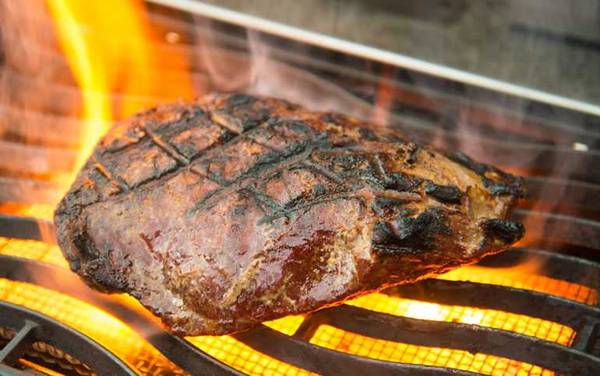Jonas-Switzerland
TVWBB Super Fan
Did my second steak on the kettle. It was terrible for my standards. I write my thoughts down to put them in order. Maybe you can chime in with your superior wisdom.
My perfect steak has an edge-to-edge medium rare to medium doneness. I used to cook them on the gasser, pre heated the cast iron grates, full sear, and then an indirect finish at 120c/275f.
My first steak on the kettle was pretty good. I used a single weber basket full of lump charcoal. Similar to this video, I seared both steaks for 30secs on the flame and 30secs off, for several round
Always with the lid off. Apart from the indirect finish until it had the right doneness.
Today, I was in a rush (always a bad idea). I did want to improve the sear, so I used two baskets, but I misjudged my chimney starter. I had 1 full, and one half-full basket. I gave them 30secs each side with the lid off, but blew some extra air into the coals to hopefully improve the sear. Then I closed the lid to speed up the cook. Now another 30secs each side, for two rounds. Again, I let the other piece cook indirectly while one was directly over the coals. Afterwards I checked the steaks for doneness by pressing on them, and cursed: It was as hard as "well-done" overcooked steak. It was on the grill for 6-9mins.
Then I cut it up and...

It was not well-done internally. You see here a cut from the side of the steak, cut-up for my kid. It had a big "cooked" grey border, and the center was medium. But it was as tough overcooked steak.
That's why this cook stays in my head. Any time I did a similarly tough steak, I had a more cooked steak. This here was one of the toughest medium steaks I had. Something I did made them extra tough, and I wonder what it was.
Certainly the indirect cook was on the hot side. The dome thermometer was around180C-200C. But it was closer to the coals than the resting steak. Then again, I also lifted the lid regularly.
The closed lid while searing itself puzzles me. Because I also grilled steaks with the lid down on the gasser, and never eith that of a bad result. I wonder if the lid of a charcoal vs gas grill results in a meaningfully different cooking chamber.
The technique of the video definitely helps with having more edge-to-edge color. The first steaks saw several more rounds of sear+rest, and had a much more red. I wonder if a cool-off period between sears also helps with tenderness.
My perfect steak has an edge-to-edge medium rare to medium doneness. I used to cook them on the gasser, pre heated the cast iron grates, full sear, and then an indirect finish at 120c/275f.
My first steak on the kettle was pretty good. I used a single weber basket full of lump charcoal. Similar to this video, I seared both steaks for 30secs on the flame and 30secs off, for several round
Always with the lid off. Apart from the indirect finish until it had the right doneness.
Today, I was in a rush (always a bad idea). I did want to improve the sear, so I used two baskets, but I misjudged my chimney starter. I had 1 full, and one half-full basket. I gave them 30secs each side with the lid off, but blew some extra air into the coals to hopefully improve the sear. Then I closed the lid to speed up the cook. Now another 30secs each side, for two rounds. Again, I let the other piece cook indirectly while one was directly over the coals. Afterwards I checked the steaks for doneness by pressing on them, and cursed: It was as hard as "well-done" overcooked steak. It was on the grill for 6-9mins.
Then I cut it up and...

It was not well-done internally. You see here a cut from the side of the steak, cut-up for my kid. It had a big "cooked" grey border, and the center was medium. But it was as tough overcooked steak.
That's why this cook stays in my head. Any time I did a similarly tough steak, I had a more cooked steak. This here was one of the toughest medium steaks I had. Something I did made them extra tough, and I wonder what it was.
Certainly the indirect cook was on the hot side. The dome thermometer was around180C-200C. But it was closer to the coals than the resting steak. Then again, I also lifted the lid regularly.
The closed lid while searing itself puzzles me. Because I also grilled steaks with the lid down on the gasser, and never eith that of a bad result. I wonder if the lid of a charcoal vs gas grill results in a meaningfully different cooking chamber.
The technique of the video definitely helps with having more edge-to-edge color. The first steaks saw several more rounds of sear+rest, and had a much more red. I wonder if a cool-off period between sears also helps with tenderness.
Last edited:



:max_bytes(150000):strip_icc()/__opt__aboutcom__coeus__resources__content_migration__serious_eats__seriouseats.com__images__2013__06__20130611-steak-multiple-flip-tomato-cucumber-salad-recipe-02-60d6352a578340d8bd24e6331feec1db.jpg)